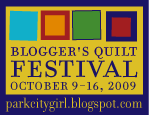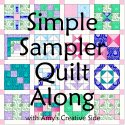Great Applique Tools!
>> Tuesday, November 17, 2009
Tired of burned fingers, crimpy applique? This evening, as I was trying to avoid first degree burns on my hands, I reached in my drawer of tools and grabbed my Cricut Spatula. It's a very thin, flat spatula. This tool worked wonderfully by holding my fabric down as I used the mini-iron to turn the edges. Because it is thin, it gives a crisp edge. It's about one inch wide which is just the right to hold a small length of fabric. It costs around $5.95 US dollars and you can find it in craft stores or Walmart.
I also use a small metal knife from a child's picnic set. It doesn't cut, but it's good for ironing like the spatula. Your fingers will thank you!
Have you noticed how expensive those pressing sheets are? Did you know Parchment Paper (you can purchase at your grocery store) works just as well?
Do you wonder why ironing boards are so narrow? Not too helpful when you're ironing a quilt top. Sharon Schamber has a great video on You Tube that shows how to make a great pressing board that you put on top of your ironing board. The firm surface makes a huge difference with piecing. Here's a lousy photo of mine:
Get yourself an early Christmas present and enjoy quilting today!
I also use a small metal knife from a child's picnic set. It doesn't cut, but it's good for ironing like the spatula. Your fingers will thank you!
Have you noticed how expensive those pressing sheets are? Did you know Parchment Paper (you can purchase at your grocery store) works just as well?
Do you wonder why ironing boards are so narrow? Not too helpful when you're ironing a quilt top. Sharon Schamber has a great video on You Tube that shows how to make a great pressing board that you put on top of your ironing board. The firm surface makes a huge difference with piecing. Here's a lousy photo of mine:
(Please ignore the messy sewing room). Simply put, get a piece of plywood (mine is two feet by four feet), spray one side with glue, layer with a piece of batting that is about five inches larger than the surface, spray batting surface with glue, layer with a piece of canvas or duck cloth that is about five inches larger than the plywood, flip over, staple excess canvas/batting to back of board, pulling corners and sides taunt. Now flip back over, spray heavily with water and let dry (this shrinks the canvas to make it tighter).
For appliqueing I read somewhere on the web to use a silver gel pen for tracing your pattern on your foundation piece and the piece itself. It shows up on all fabrics. Yes, it's permanent, but it forces you to make your edges meet! I like working with it.
My favorite applique stitch is the ladder stitch. Ami Simms has a great video on QNN that shows how to make her "Invisible Applique" and she also has a great little book about this technique. It truly is invisible.
And finally, I discovered at Bed Bath and Beyond a wonderful lap desk that I converted into a hand sewing and applique desk. In the cup holder I stuffed a pin cushion and in the pencil holder I keep a seam ripper (I'm sure you're shocked anyone would need that--certainly not you!) The light above really helps you see your mistakes stitches. It only cost $19. 99 I've seen something similar, specifically for sewing, for over $50 at a quilt shop.
Get yourself an early Christmas present and enjoy quilting today!








0 comments:
Post a Comment